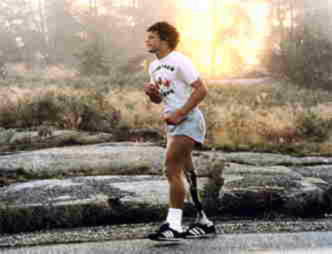 by Preston MacDougall June 29, 2005
I am not referring to the elation that Steve Miller must have been experiencing when he wrote "High On You Mama," after all, he was a self-confessed "joker, smoker and midnight toker."
I used to live in Los Alamos, New Mexico, which is almost half a mile higher than Denver, the mile-high city. So I know very well how majestic the Sangre de Christo Mountains are, and that one need not take in anything other than the scenery to feel a "Rocky Mountain High." But this isn't what I am referring to either. I refer to the natural high that we feel when the brain is briefly flooded with endorphins, molecules which have a physiological effect similar to morphine. (I'll have to trust the literature on that one.) These molecules are "homemade brain food" in the sense that the chemical plants in the head office of our own bodies, our brain cells, synthesize them out of smaller feedstock molecules on a regular basis. Biochemists are still trying to sort out why morphine simulates a strong endorphin response. This puzzle is complicated by the fact that there is not one endorphin molecule involved, but a family of them. Our brains use these molecules to regulate feelings related to pain, hunger and sex, so there is naturally lots of interest in them, both medically and commercially. Most endorphins are constructed out of a small number of amino acids, from two to a few dozen. But since there are twenty amino acids used to construct proteins in our bodies, this creates a very large number of possibilities. Many endorphin molecules have been isolated from the pituitary gland, where they are particularly concentrated, but there are certainly many more waiting to be discovered. The molecular structure of morphine has some similarities to simple endorphins, but to a chemist the resemblance is not striking. What is unmistakable though, is the feeling of euphoria that accompanies the release of endorphins in the brain. I am told that runners experience this approximately midway through a marathon race. The furthest I have run in a race is 10K, which might explain why I don't particularly enjoy running. I doubt that the Greek warrior who ran from Marathon to Athens, in 490 B.C., volunteered for the task. After all, legend has it that he collapsed and died when he delivered his message of victory. Yet my good friend David Jones is an ultra-marathon enthusiast, racing 100 miles, often uphill or in the desert. From my perspective, that anyone would volunteer to do this, for fun, is tantamount to proof that "runner's high" must be a real phenomenon. To athletes, the "agony of defeat" may be the flip-side of the "thrill of victory," but for ABC's Wide World of Sports they are both money in the bank. Likewise, as far as brain chemistry is concerned, they are both consequences of the same molecular chain reaction. On rare occasions, the same athlete will go from agony to victory, with help from endorphins along the way no doubt. The most obvious example is Lance Armstrong, the cyclist from the plains of Texas who survived brain surgery and intense chemotherapy after he was diagnosed with testicular cancer that had metastasized and spread to his lungs and brain. While his cancer was in remission, he resumed his training, and eventually won the Tour de France an amazing six consecutive times. A feat unmatched in the near century of this mountainous bicycle race, but one that he might surpass himself in 2005. My daughter, who was also born in Texas, is among the millions of people, young and old, who sport yellow LiveStrong wristbands. For uplifting personal stories of courageous battles with cancer, or to contribute to research that aims to improve the quality of life of cancer survivors, go to www.livestrong.org. Inspiring? Yes. Pinnacle of athletic achievement? Perhaps. Most heroic athletic performance by a person living with cancer? Surprisingly not. At least not for someone living in Canada during the 80's, such as myself. Let me tell you about Terry Fox. Terry Fox was born in the Canadian prairies, in Winnipeg, Manitoba. So his geographical origins are similar to Lance Armstrong's. He also had a youth that was endorphin enhanced by virtue of his love of sport and athletic training. Unfortunately, he too was diagnosed with cancer at a young age. (Terry was 18 in 1977 when his doctors amputated his right leg six inches above the knee in an attempt to stop the spread of his bone cancer.) Terry and Lance must have been similarly impacted by the courage that they witnessed in the cancer wards of their respective hospitals. While Terry's cancer was in remission, he decided to raise money for cancer research, and began his own regimen of training for what he would call his Marathon of Hope. Do you have some tissues handy? Terry Fox dipped the shoe at the end of a pole-like prosthetic serving as his right leg, in the Atlantic Ocean on April 12, 1980. He then proceeded to run, with what soon became an endearing skip-like gait, across Canada. He ran a marathon, every day, for 143 consecutive days, in rain or shine, or whatever else the Canadian weather dished out. He had covered two-thirds of Canada's wide expanse, totaling 5,373 kilometers, when he was forced to halt his run near Thunder Bay, Ontario. His cancer had returned, and all the endorphins that his brain cells could produce were no match for the pain. He died within a year, but still holding onto the dream of sending his cancer back into remission and completing his cross-country race. He didn't accomplish his athletic goal, but his ultimate goal of raising $1 for every Canadian was reached while he was alive. Please visit www.terryfoxrun.org for progress on extending Terry's hope worldwide.
|
||
